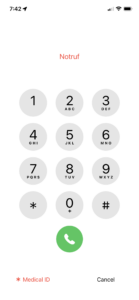With CAD, as with many health issues. It is wise to have some form of Medical ID that is on you at all times. No single precaution may cover you in any given situation. So the more options you cover. The better chance you may have of someone seeing it.
Also be aware. No matter what form of medical information you record somewhere. There is no guarantee any first responder is going to seek that information out. Let alone pay attention to anything they may read.
Administering cold saline almost appears to be standard procedure during a transport? Maybe even mandatory depending on your vitals?
[Note: reference to Warm IV during Emergency/Paramedic situations mostly pertains to common IV’s, like saline.
We are not talking about some of the pharmaceutical IV’s that are administered in a clinical/hospital situation that can’t be pre-warmed without damaging the product. Though other means of body warming right at the IV point are often used on CAD patients. These are not administered in a Paramedic/Ambulance situation. So not something to debate about]
You have to realize that many Doctors, let alone nursing staff, and phlebotomy lab/techs have no understanding of Cold Agglutinin Disease and the effects temperature plays on impacting a patient.
In our experiences with Paramedics and ambulance services, they have even less knowledge. They will often attempt to IV with saline when told not too. Like they listen, don’t hear/don’t care, then do whatever they intended to do anyway. I have to imagine that is a trained requirement on their end? Maybe even mandatory based on vitals? Apparently CAD is not factored in?
In my wife’s situation. After I have told paramedics, and they acknowledged me. They left the house (I was not allowed in their vehicle) and attempted to saline IV my (CAD) wife. Totally against what I told them. Disregarded the threat that it may cause.
Luckily my wife was conscious. This was during cold weather. No means to warm the solution. She had some very tense moments in the ambulance, and a verbal battle, an insistent refusal. A whole scenario that should not have taken place with people that are suppose to be trained. Talk about stress!
Situations like car accidents or something resulting in being unconscious can really be a problem. If you are alone, or without a responsible loved one/advocate that knows and understands your CAD. One that can be insistent about your care and being kept warm. That is probably the worst case scenario.
Often when paramedic services arrive the first thing they do is to IV the person on saline. If that is done with cold saline, the patient is CAD and highly cold sensitive. They may well cause more damage than good. In fact causing an outcome we don’t even want to consider.
We have encountered the car accident situation too. I was home. My wife was involved in a traffic accident. Needed transported to the Emergency Room. She called me because the paramedics weren’t listening to her about not IV’ing cold saline. I spoke to the in-charge paramedic on the scene. Explained briefly her condition, and what cold saline could potentially do to her. I got his name, and repeated his name back to him.
We were fortunate they listened and didn’t IV her during the transport. They had no means to warm the solution. We are so thankful she was conscious and could refuse if they attempted to infuse her cold.
I had high stress until she called me from the Emergency Room and assured me the Emergency Rood was also complying with using a warm IV.
Many CAD’s may not be that affected by a Cold IV? Others such as my wife that are very sensitive and reactive to the Cold, are at a higher risk. Then there is that whole bulk group of CAD’s that fall somewhere in the middle.
There are various forms of displaying this information.
* Medical Bracelet
* Medical Bracelet with paid service (telephone number to call)
* Medical Card in Wallet
* Emergency Medical/Health section in your Cell Phone
I am going to skip over the first three. They have been around and most people are aware of them. Easy to search the internet for services that provide these to patients.
The cell phone section may be new, or unknown to many. Its free and can retain lots of detail. It is helpful to have your outlined explanation of (CAD) Cold Agglutinin Disease . What it is. Your need to be kept warm as being very critical. Also some explicit notes to not IV you with cold liquids unless it is run through a blood warmer at 98.6°F/37°C.
First responders can access this from your main screen (if you have it activated and filled out) without the need for your password, thumbprint, or facial recognition. Will they in such a situation? Who knows?
On an iPhone the word EMERGENCY appears in the lower left (on the password screen). First responders can simply press that. On the next screen the words *Medical ID will appear in the lower left. When they press that, they have access to the information you have previously typed. If you activated/enabled/shared that, and saved it.
My CAD wife has a detailed explanation of CAD on her phone. Her CAD precautions. Name and contact Telephone numbers of her Hematologist, current medications and doses, and more. I am non-CAD and even did the same on my phone for myself.
On the iPhone to set it up (As of 2021)
SETTINGS/HEALTH/ Under the Medical Details category there is Health Details and Medical ID. Populate your info. Then make sure they are activated to “share” or “enable” on a “locked screen”
When you have saved it. Be sure to test it from a locked screen. If you use facial recognition, hand the phone to someone else to test it from a locked screen.
![]()

